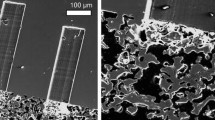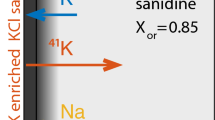Abstract
Diffusion of Al in synthetic forsterite was studied at atmospheric pressure from 1100 to 1500 °C in air along [100] with activities of SiO2, MgO and Al2O3 (aSiO2, aMgO and aAl2O3) buffered. At low aSiO2, the buffer was forsterite + spinel + periclase (fo + sp + per) at all temperatures, while at high aSiO2 and subsolidus conditions a variety of three-phase assemblages containing forsterite and two other phases from spinel, cordierite, protoenstatite or sapphirine were used at 1100–1350 °C. Experiments at high aSiO2 and 1400 °C used forsterite + protoenstatite + melt (fo + en + melt), and at 1500 °C, fo + melt. The resulting diffusion profiles were analysed by LA–ICP–MS in scanning mode. Diffusion profiles in the high aSiO2 experiments were generally several hundred microns in length, but diffusion at low aSiO2 was three orders of magnitude slower than in high aSiO2 experiments carried out at the same temperature, producing short profiles only a few microns in length and close to the spatial resolution of the analytical method. Interface concentrations of Al in the forsterite, obtained by extrapolating the diffusion profiles to the crystal/buffer interface, were only a fraction of those expected at equilibrium, and varied among the differing buffer assemblages according to (aAl2O3)1/2 and (aSiO2)3/4, pointing to the substitution of Al in forsterite by an octahedral-site, vacancy-coupled (OSVC) component with the stoichiometry Al 3+4/3 vac2/3SiO4, whereas the main substitution expected from previous equilibrium studies would be the coupled substitution of 2 Al for Mg + Si, giving the stoichiometry MgAl2O4. It is proposed that this latter substitution is not seen on the length scales of the present experiments because it requires replacement of Si by Al on tetrahedral sites, and is accordingly rate-limited by the slow diffusivity of Si. Instead, diffusion of Al by the OSVC mechanism is relatively fast, and at high aSiO2, even faster than Fe–Mg interdiffusion.






Similar content being viewed by others
References
Agee CB, Walker D (1990) Aluminum partitioning between olivine and ultrabasic silicate liquid to 6-Gpa. Contrib Miner Petrol 105:243–254
Batanova VG, Sobolev AV, Kuzmin DV (2015) Trace element analysis of olivine: high precision analytical method for JEOL JXA-8230 electron probe microanalyser. Chem Geol 419:149–157
Beattie P (1994) Systematics and energetics of trace-element partitioning between olivine and silicate melts—implications for the nature of mineral melt partitioning. Chem Geol 117:57–71
Berry AJ, Hermann J, O’Neill HSC, Foran GJ (2005) Fingerprinting the water site in mantle olivine. Geology 33:869–872
Berry AJ, O’Neill HSC, Hermann J, Scott DR (2007) The infrared signature of water associated with trivalent cations in olivine. Earth Planet Sci Lett 261:134–142
Bershov LV, Gaite JM, Hafner SS, Rager H (1983) Electron-paramagnetic resonance and endor studies of Cr3+–Al3+ pairsin forsterite. Phys Chem Miner 9:95–101
Chakraborty S (2010) Diffusion coefficients in olivine, wadsleyite and ringwoodite. Rev Miner Geochem 72:603–639
Colson RO, Mckay GA, Taylor LA (1989) Charge balancing of trivalent trace-elements in elivine and low-Ca pyroxene—a test using experimental partitioning data. Geochim Cosmos Acta 53:643–648
Connolly JAD, Petrini K (2002) An automated strategy for calculation of phase diagram sections and retrieval of rock properties as a function of physical conditions. J Metamorph Geol 20:697–708
Coogan LA, Saunders AD, Wilson RN (2014) Aluminum-in-olivine thermometry of primitive basalts: evidence of an anomalously hot mantle source for large igneous provinces. Chem Geol 368:1–10
Dohmen R, Chakraborty S (2007) Fe–Mg diffusion in olivine II: point defect chemistry, change of diffusion mechanisms and a model for calculation of diffusion coefficients in natural olivine. Phys Chem Miner 34:597–598
Dohmen R, Becker HW, Chakraborty S (2007) Fe-Mg diffusion in olivine I: experimental determination between 700 and 1,200 degrees C as a function of composition, crystal orientation and oxygen fugacity. Phys Chem Miner 34:389–407
Dohmen R, Kasemann SA, Coogan L, Chakraborty S (2010) Diffusion of Li in olivine. Part I: Experimental observations and a multi species diffusion model. Geochim Cosmos Acta 74(1):274–292
Evans TM, O’Neill HSC, Tuff J (2008) The influence of melt composition on the partitioning of REEs, Y, Sc, Zr and Al between forsterite and melt in the system CMAS. Geochim Cosmos Acta 72:5708–5721
Fei H, Hegoda C, Yamazaki D, Wiedenbeck M, Yurimoto H, Shcheka S, Katsura T (2012) High silicon self-diffusion coefficient in dry forsterite. Earth Planet Sci Lett 345:95–103
Foley SF, Jacob DE, O’Neill HSC (2011) Trace element variations in olivine phenocrysts from Ugandan potassic rocks as clues to the chemical characteristics of parental magmas. Contrib Miner Petrol 162:1–20
Grant KJ, Wood BJ (2010) Experimental study of the incorporation of Li, Sc, Al and other trace elements into olivine. Geochim Cosmos Acta 74:2412–2428
Heinonen JS, Jennings ES, Riley TR (2015) Crystallisation temperatures of the most Mg-rich magmas of the Karoo LIP on the basis of Al-in-olivine thermometry. Chem Geol 411:26–35
Holland TJB, Powell R (2011) An improved and extended internally consistent thermodynamic dataset for phases of petrological interest, involving a new equation of state for solids. J Metamorph Geol 29:333–383
Ingrin J, Kovács I, Deloule E, Balan E, Blanchard M, Kohn SC, Hermann J (2014) Identification of hydrogen defects linked to boron substitution in synthetic forsterite and natural olivine. Am Miner 99(10):2138–2141
Jaoul O, Houlier B, Abel F (1983) Study of 18O diffusion in magnesium orthosilicate by nuclear microanalysis. Geophys Res Lett 88:613–624
Jollands MC, O’Neill HSC, Hermann J (2014) The importance of defining chemical potentials, substitution mechanisms and solubility in trace element diffusion studies: the case of Zr and Hf in olivine. Contrib Miner Petrol 168:1055
Jollands MC, Burnham AD, O’Neill HSC, Hermann J, Qian Q (2016a) Beryllium diffusion in olivine: a new tool to investigate timescales of magmatic processes. Earth Planet Sci Lett 450:71–82
Jollands MC, Hermann J, O’Neill HSC, Spandler C, Padrón-Navarta JA (2016b) Diffusion of Ti and some divalent cations in olivine as a function of temperature, oxygen fugacity, chemical potentials and crystal orientation. J Petrol 57(10):1983–2010
Mallmann G, O’Neill HSC, Klemme S (2009) Heterogeneous distribution of phosphorus in olivine from otherwise well-equilibrated spinel peridotite xenoliths and its implications for the mantle geochemistry of lithium. Contrib Miner Petrol 158:485–504
Mao H, Fabrichnaya O, Selleby M, Sundman B (2005) Thermodynamic assessment of the MgO–Al2O3–SiO2 system. J Mater Res 20:975–986
Martrosov VN, Matrosova TA, Kupchenko MI, Pestryakov EV, Pavlovskij LK (2002) Growth of activated forsterite crystals. Poverkhnost Rentgenovskie sinkhronnye i nejtronnye issledovaniya 5:30–34
McKibbin SJ, O’Neill HC, Mallmann G, Halfpenny A (2013) LA–ICP–MS mapping of olivine from the Brahin and Brenham meteorites: complex elemental distributions in the pallasite olivine precursor. Geochim Cosmos Acta 119:1–17
Milman-Barris MS, Beckett JR, Baker MB, Hofmann AE, Morgan Z, Crowley MR, Vielzeuf D, Stolper E (2008) Zoning of phosphorus in igneous olivine. Contrib Miner Petrol 155:739–765
Nielsen RL, Gallahan WE, Newberger F (1992) Experimentally determined mineral-melt partition-coefficients for Sc, Y and Ree for olivine, ortho-pyroxene, pigeonite, magnetite and ilmenite. Contrib Miner Petrol 110:488–499
O’Neill HSC (1987) Quartz-fayalite-iron and quartz-fayalite-magnetite equilibria and the free energy of formation of fayalite (Fe2SiO4) and magnetite (Fe3O4). Am Miner 72:67–75
O’Neill HSC, Eggins SM (2002) The effect of melt composition on trace element partitioning: an experimental investigation of the activity coefficients of FeO, NiO, CoO, MoO2 and MoO3 in silicate melts. Chem Geol 186(1):151–181
Qian Q, O’Neill HSC, Hermann J (2010) Comparative diffusion coefficients of major and trace elements in olivine at similar to 950 degrees C from a xenocryst included in dioritic magma. Geology 38:331–334
Spandler C, O’Neill HSC (2010) Diffusion and partition coefficients of minor and trace elements in San Carlos olivine at 1,300 degrees C with some geochemical implications. Contrib Miner Petrol 159:791–818
Spandler C, O’Neill HSC, Kamenetsky VS (2007) Survival times of anomalous melt inclusions from element diffusion in olivine and chromite. Nature 447:303–306
Spice H, Sanloup C, Cochain B, de Grouchy C, Kono Y (2015) Viscosity of liquid fayalite up to 9 GPa. Geochim Cosmos Acta 148:219–227
Taura H, Yurimoto H, Kurita K, Sueno S (1998) Pressure dependence on partition coefficients for trace elements between olivine and the coexisting melts. Phys Chem Miner 25:469–484
Tollan PME, O’Neill HSC, Hermann J, Benedictus A, Arculus RJ (2015) Frozen melt-rock reaction in a peridotite xenolith from sub-arc mantle recorded by diffusion of trace elements and water in olivine. Earth Planet Sci Lett 422:169–181
Tuff J, O’Neill HSC (2010) The effect of sulfur on the partitioning of Ni and other first-row transition elements between olivine and silicate melt. Geochim Cosmos Acta 74:6180–6205
Wan ZH, Coogan LA, Canil D (2008) Experimental calibration of aluminum partitioning between olivine and spinel as a geothermometer. Am Miner 93:1142–1147
Watson EB, Cherniak DJ, Holycross ME (2015) Diffusion of phosphorus in olivine and molten basalt. Am Miner 100:2053–2065
Zhang FW, Wright K (2010) Coupled (H+, M3+) substitutions in forsterite. Geochim Cosmos Acta 74:5958–5965
Zhukova IA, O’Neill HSC, Campbell IH, Kilburn MR (2014) The effect of silica activity on the diffusion of Ni and Co in olivine. Contrib Miner Petrol 168:1–15
Author information
Authors and Affiliations
Corresponding author
Additional information
Communicated by Othmar Müntener.
Rights and permissions
About this article
Cite this article
Zhukova, I., O’Neill, H. & Campbell, I.H. A subsidiary fast-diffusing substitution mechanism of Al in forsterite investigated using diffusion experiments under controlled thermodynamic conditions. Contrib Mineral Petrol 172, 53 (2017). https://doi.org/10.1007/s00410-017-1365-x
Received:
Accepted:
Published:
DOI: https://doi.org/10.1007/s00410-017-1365-x




